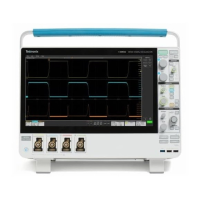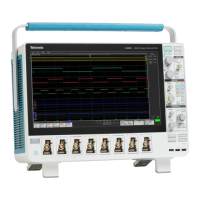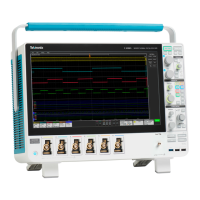Commands listed in alphabetical order
BURSTWIDTH (Bu
rst Width) is the duration of a series of adjacent crossings of the
Mid reference level (RM) . Bursts are separated by a user-defined idle time (tI).
This measurement is made on each burst in t he record.
COMMONMODE (DC C ommon Mode) is the arithmetic mean of the common mode
voltage of two sources. This measurement is made across the entire record.
DATARATE (Data Rate) is the reciprocal of Unit Interval. This measurement is
made on each bit in the record.
DCD (duty cycle distortion) is the peak-to-peak amplitude of the component of
the deterministic jitter correlated with the signal polarity. This measurement is
made across the entire record.
DDJ (data dependent jitter) is the peak-to-peak amplitude of the component of
the deterministic jitter correlated with the data pattern in the waveform. This
measurement is ma de across the entire record.
DELay is the time between the s pecified Mid reference level (RM) crossing on
one source to a specified Mid reference level (RM) crossing on a second source.
This measurement is made on the first occurrence in the record.
DJ (deterministic jitter) is the peak-to-peak amplitude of all timing errors that
exhibit deterministic behavior. This measurement is made across the entire record.
DJDIRAC (dual-dirac deterministic jitter) is deterministic jitter based on a
simplifying assumption that the histogram of all deterministic jitter can be
modeled as a pair of equal-magnitude
Dirac functions. This measurement is made
across the entire record.
EYEHIGH (Eye High) is the amplitude of a h
igh (1) bit measured at a user specified
location w ithin the recovered unit interval. This measurement is m ade on each
high bit in the record.
EYELOW (Eye Low) is the amplitude of a low (0) bit measured at a user specified
location w ithin the recovered unit interval. This measurement is m ade on each
low bit in the record.
FALLSLEWRATE (Falling Slew Rate) is the rate of change in voltage as an edge
transitions from the Top reference level (RT) to the Bottom reference level (RB).
This measurement is made on each cycle in the record.
FALLTIME (Fall Time) is the time required for an edge to fall from the Top
reference level (RT) to the Base r eference level (RB). This measurement is made
on each cycle in the record.
FREQuency is the reciprocal of Period. This measurement is made on e ach cycle
in the record.
F2 is the peak-to-peak amplitude of the periodic jitter occurring at a rate of Fb
(data rate) divided by 2. This measurement is made across the entire record.
F4 is the peak-to-peak amplitude of the periodic jitter occurring at a rate of Fb
(data rate) divided by 4. This measurement is made across the entire record.
2-490 MSO54, MSO56, MSO58, MSO58LP Programmer

